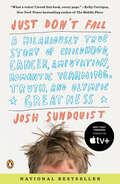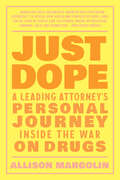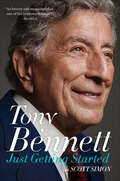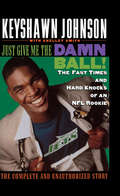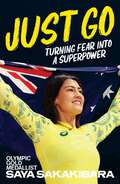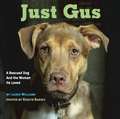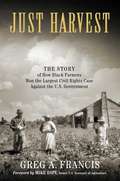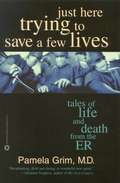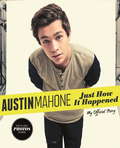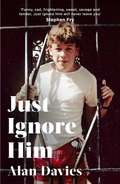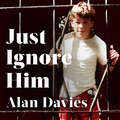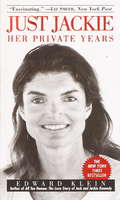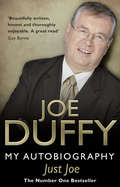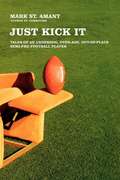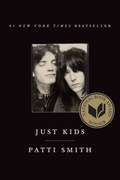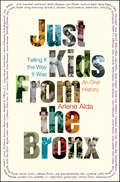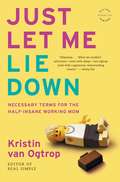- Table View
- List View
Just Don't Fall: A Hilariously True Story of Childhood, Cancer, Amputation, Romantic Yearning, Truth, and Olympic Greatness
by Josh SundquistAn Act of Courage
Just Dope: A Leading Attorney's Personal Journey Inside the War on Drugs
by Allison MargolinFor readers of Dopesick and In the Realm of Hungry Ghosts, a celebrated cannabis attorney's personal look at the War on Drugs and what comes next for the drug legalization movementGetting high is something most of us do, and in many cases do safely--yet drugs remain a singular public enemy. In a ranging blend of memoir, pop culture, policy critique, and social analysis, LA-based criminal defense attorney Allison Margolin explores why--and what we can do about it.Informed by Margolin&’s experiences as a drug user, advocate, and the daughter of California&’s most renowned (and infamous) cannabis attorney, Just Dope offers a look at where our current drug policy fails. It exposes the true history of drug prohibition in the United States, sharing why it started, how it evolved, and where it stands now. And it looks unflinchingly at the false dichotomy between &“good&” drugs and &“bad&” drugs and Margolin&’s experience with programs like D.A.R.E that misguidedly ask you to &“Just Say No.&”For readers of All Day is a Long Time and In the Realm of Hungry Ghosts, Just Dope is an experiential tour-de-force of personal essay and whip-smart policy critique—and a vital call to knowledge and action.
Just For The Record
by Geri HalliwellIn 2002, Just For The Record was the book that everyone was talking about. Then in 2003, repackaged in a new, compact mass-market format, Just For The Record did it all over again being one of the most read books of the year. Since the break up of the Spice Girls, Geri has continued to intrigue the media and the masses. But how many of the stories are true? Just For The Record reveals all. With particular focus on her personal battle to overcome the eating disorders that have plagued her since childhood, and the stark reality of weight obsession, Geri shares the facts about life after the girl band. This is Geri's story: revealing, frank, brutally honest, and at times shocking.
Just Getting Started
by Scott Simon Tony Bennett“For my money, Tony Bennett is the best singer in the business, the best exponent of a song. He excites me when I watch him. . . . He moves me. He’s the singer who gets across what the composer has in mind, and probably a little more.” — Frank Sinatra“As breezy and meaningful as one of his trademark songs as readers learn about the man by the company he kept and the heroes he worships. Bennett’s ethereal still lifes and landscape paintings adorn this simple yet profound and gracious homage.”— BooklistTony Bennett was one of our most vibrant musicians ever to grace the stage. In his previous book, Life Is a Gift, Tony reflected on the lessons he learned over the years. In Just Getting Started, he pays homage to the remarkable people who inspired those lessons.In his warm and inviting voice, Tony talks about who and what have enriched his own life, including Charlie Chaplin, Judy Garland, Dr. Martin Luther King, Jr., Cole Porter, Amy Winehouse, Fred Astaire, Lady Gaga, members of his family, significant places, and more. Just Getting Started chronicles the relationship Tony enjoyed with each one of these legends, entertainers, humanitarians, and loved ones, and reveals how the lessons and values they imparted have invaluably shaped his life.As enchanting and unforgettable as his music, Just Getting Started is a beautiful compilation of reflections every Bennett fan will treasure, and a perfect introduction for those just getting to know this remarkable star and humanitarian.
Just Give Me A Cool Drink Of Water 'Fore I Diiie
by Dr Maya AngelouA marvellous collection of poetry from the beloved and bestselling author of I KNOW WHY THE CAGED BIRD SINGS. 'A brilliant writer, a fierce friend and a truly phenomenal woman' BARACK OBAMAPoems of love and regret, of racial strife and confrontation, songs of the people and songs of the heart - all are charged with Maya Angelou's zest for life and her rage at injustice. Lyrical, tender poems of longing, wry glances at betrayal and isolation combine with a fierce insight into 'hate and hateful wrath' in an unforgettable picture of the hopes and concerns of one of America's finest writers. 'She moved through the world with unshakeable calm, confidence and a fierce grace . . . She will always be the rainbow in my clouds' OPRAH WINFREY 'She was important in so many ways. She launched African American women writing in the United States. She was generous to a fault. She had nineteen talents - used ten. And was a real original. There is no duplicate' TONI MORRISON
Just Give Me the Damn Ball!: The Fast Times and Hard Knocks of an NFL Rookie
by Keyshawn Johnson Shelley SmithThe Jets drafted me as the number-one player in the NFL draft. But that first day, the day of the draft, was one of the happiest days in my life, because I knew I was ready to make things happen in the league and help turn things around for the sorry-ass Jets. But what a nightmare! Week after week, loss after loss. The Jets went in with a loser reputation, and they were earning it all over again. We had no emotion, no energy, no hunger. The media tried to cover it all. Rich Kotite tried to explain the disasters away. But nobody outside the team knew the real truth of what really went on. This book is going to change all that.
Just Go: A Globe-Trotting Guide to Travel Like an Expert, Connect Like a Local, and Live the Adventure of a Lifetime
by Drew BinskyUSA TODAY BESTSELLER Popular travel YouTuber and content creator Drew Binsky, who has visited every single country, walks readers through the most amazing places in the world and shares everything you need to know to go anywhere you want. In 2021, Drew Binsky completed his 10-year journey to travel to every country in the world—all 197 of them. Now, for the first time, Drew reveals his craziest stories and best moments, even from places the UN deems the most &“dangerous&” like Afghanistan, Somalia, Syria, and Yemen. As you&’ll discover with Drew as your guide, the world is more accessible than you think—and no matter where we&’re from, people around the globe have more in common with us than differences. Just Go offers readers the adventure of a lifetime, presenting not only the tricks Drew himself used in his trips, but also the best-kept secrets from every corner of the world. Just Go is equally a practical handbook for globetrotters and aspiring travelers as it is an intimate and heartwarming celebration of people and cultures all over. In this fun and friendly guide, Drew will show you how to: Obtain visas for obscure destinations Make fast friends with trustworthy locals Find and enjoy street food like a pro Navigate language barriers Have the greatest adventure of your life As one of the few people who traveled the globe in 2020, Drew witnessed and recorded the pandemic response in countries everywhere—and realized how crucial it is for the world to reconnect. In Just Go, filled with photos, stories, and tips Drew has never before shared, you&’ll find the toolkit and the inspiration to do just that: get out there and go wherever you want!
Just Go: Turning fear into a superpower
by Saya SakakibaraSaya Sakakibara triumphed over fear, self-doubt and family tragedy to become an Olympic champion. Her journey will inspire you to face your fears and unlock your greatest potential.Just go. It&’s a mantra I&’ve always come back to, to keep me focused on what I need to do and filter out everything else.Saya loved BMX racing, but a series of devastating accidents turned her passion into paralysing fear. Her brother Kai suffered a traumatic brain injury on the track, then Saya herself was battered by multiple crashes and concussions. With every race risking further injury, Saya felt she had to walk away from BMX – but quitting wasn&’t so simple.After everything, Saya couldn&’t let go of her Olympic dream. She needed to see how far she could go if she faced her fears and truly believed in herself. Ultimately, Saya decided to just go. This is a story of resilience, self-discovery, and the determination to keep going when the road ahead feels uncertain. Saya&’s journey is a powerful reminder that overcoming fear and embracing the challenges along the way can lead to the greatest triumphs.
Just Gus
by Roslyn Banish Laurie WilliamsGus was a lucky dog. Injured and abandoned, he could have become another of the 7 million animals euthanized every year. Then Stephanie Williams entered the picture. A successful journalist, she had been diagnosed with late-stage breast cancer at the age of 30. On medical leave and living alone, she wanted a warm four-legged companion. When she saw Gus's soulful eyes and goofy grin, it was love at first sight: she would rescue him, and he would return the favor.Just Gus is about how much one dog did to make a dying woman happy - giving tireless love, comfort, and support. This extraordinary story shows how one dog brought joy and hope to a woman's last days.
Just Harvest: The Story of How Black Farmers Won the Largest Civil Rights Case against the U.S. Government
by Greg FrancisWhen a class-action lawsuit against the US government results in a billion dollar settlement for the aggrieved parties, you&’d expect the story to be headline news . . .to be posted on social media everywhere . . . to be adapted to film or even to a popular legal procedural series on TV . . .So why then have so many people never heard of Pigford vs. Glickman? Or the follow-up lawsuit, Pigford II? Or the Black Farmers Case, as the pair of these legal actions is often called? Could it be that the heart-wrenching story of Black farmers in America, and the monumental legal case that brought long-sought justice to them, is rarely told because it reflects so poorly on the US and its treatment of those whose ancestors helped make the nation an agricultural giant in the first place? Whatever the reason, the time to tell the full story has come and the person to share the gripping details is Greg Francis, one of the lead counsels in the historic case that finally helped Black farmers achieve equity. In Just Harvest, Francis narrates the dramatic twists and turns of the legal battle fought and won, and evidences the many years of ingrained discrimination and racism that preceded it. Awareness of this story makes us all witnesses to the history still unfolding— and while parts of what is recounted herein will enrage you, the hope is that this book will also inspire, inform, and motivate you to join the continuing fight for the rights of all Black farmers now and in the future.
Just Here Trying to Save a Few Lives: Tales of Life and Death From the ER
by Pamela GrimAn account that will profoundly move you and, like Oliver Sacks's An Anthropologist on Mars, forever change the way you look at medicine, Just Here Trying to Save a Few Lives introduces a passionate, eloquent new voice. Author and emergency room physician Pamela Grim not only takes you into her dramatic life-and-death world but, in unforgettable prose, shows us the almost unbearable decisions and the heartbreaking conflicts of a woman who just might someday save your life.Here is life on the front lines of medicine, from modern, well-stocked American ERs to third-world clinics devoid of even the most basic equipment. Here a newborn fights for his life, a would-be suicide arrives with a dozen prescription bottles, a teenager lies bleeding with gunshot wounds to the chest, a hundred needy children wait for treatment in a makeshift hospital in Bosnia, and a thousand more people, desperate and dying, hope for some relief in sub-Sahara Africa. Here sleep-deprived doctors perform heroic procedures only to see patients die ... yet they still manage to pull off miracles. As she opens the doors to this adrenaline-fueled environment, Dr. Grim also bares her soul and describes her own personal journey ... including her struggle with burnout and the crisis of faith that drove her to practice medicine in countries ravaged by infectious diseases, poverty, and war.More relentlessly compelling than any medical thriller, Just Here Trying to Save a few Lives has the power to leave you richer. It will lead you to appreciate the resilience of the human body and human spirit as never before, and will make you forever grateful that there are doctors like Pamela Grim. More relentlessly compelling than any medical thriller, Just Here Trying to Save a few Lives has the power to leave you richer. It will lead you to appreciate the resilience of the human body and human spirit as never before, and will make you forever grateful that there are doctors like Pamela Grim.
Just Here, Doctor
by Robert CliffordJust Here, Doctor is the true story of a young country doctor and his patients - a richly entertaining and humorous chronicle of the life of a small West Country community as seen through the eyes of its G.P. Dr Clifford has some marvellous stories to tell: about the home delivery of a cricket fan's baby - in between overs of a televised Test Match; of the time he rode off on a gigantic horse to attend a hunting casualty - and rode back in an ambulance as the casualty; and the amazing saga of his student rugby tour of France - the craziest, most drunken ever undertaken. Here too, on the more serious side, are moving accounts of the courage of ordinary people in the face of serious, even fatal illness. Teeming with colourful and curious places and characters, Just Here, Doctor is packed with comedy, drama and tragedy, every bit as warm and enthralling as James Herriot's famous stories of a vet's life.
Just Here, Doctor (The Dr Clifford Chronicles)
by Dr Robert CliffordJust Here, Doctor is the true story of a young country doctor and his patients - a richly entertaining and humorous chronicle of the life of a small West Country community as seen through the eyes of its G.P. Dr Clifford has some marvellous stories to tell: about the home delivery of a cricket fan's baby - in between overs of a televised Test Match; of the time he rode off on a gigantic horse to attend a hunting casualty - and rode back in an ambulance as the casualty; and the amazing saga of his student rugby tour of France - the craziest, most drunken ever undertaken. Here too, on the more serious side, are moving accounts of the courage of ordinary people in the face of serious, even fatal illness. Teeming with colourful and curious places and characters, Just Here, Doctor is packed with comedy, drama and tragedy, every bit as warm and enthralling as James Herriot's famous stories of a vet's life.
Just How It Happened
by Austin MahoneSee how Austin went from being a kid from a small town in Texas singing and messing around on YouTube with his friends to headlining his own shows around the world. Complete with exclusive photos and stories from his childhood as well as lots of behind-the-scenes fun, Austin's first official book will give you the glimpse into his life you can't get by following him on Twitter. Mahomies, this book is for you!
Just Ignore Him: A BBC Two Between the Covers book club pick
by Alan Davies'A simply astonishing achievement. The quality, depth, emotional power and terrifying honesty of Alan Davies's story-telling take the breath away' Stephen Fry'This hugely affecting book is brave, insightful and, at times, funny about things it is hard to be funny about' Jo BrandThe story of a life built on sand. In the rain.In this compelling memoir, comedian and actor Alan Davies recalls his boyhood with vivid insight and devastating humour. Shifting between his 1970s upbringing and his life today, Davies moves poignantly from innocence to experience to the clarity of hindsight, always with a keen sense of the absurd.From sibling dynamics, to his voiceless, misunderstood progression through school, sexuality and humiliating 'accidents', Davies inhabits his younger mind with spectacular accuracy, sharply evoking an era when Green Shield Stamps, Bob-a-Job week and Whizzer & Chips loomed large, a bus fare was 2p - and children had little power in the face of adult motivation. Here, there are often exquisitely tender recollections of the mother he lost at six years old, of a bereaved family struggling to find its way, and the kicks and confusion of adolescence.Through even the joyous and innocent memories, the pain of Davies's lifelong grief and profound betrayal is unfiltered, searing and beautifully articulated. Just Ignore Him is not only an autobiography, it is a testament to a survivor's resilience and courage.
Just Ignore Him: A BBC Two Between the Covers book club pick
by Alan Davies'A simply astonishing achievement. The quality, depth, emotional power and terrifying honesty of Alan Davies's story-telling take the breath away' Stephen Fry'This hugely affecting book is brave, insightful and, at times, funny about things it is hard to be funny about' Jo BrandThe story of a life built on sand. In the rain.In this compelling memoir, comedian and actor Alan Davies recalls his boyhood with vivid insight and devastating humour. Shifting between his 1970s upbringing and his life today, Davies moves poignantly from innocence to experience to the clarity of hindsight, always with a keen sense of the absurd.From sibling dynamics, to his voiceless, misunderstood progression through school, sexuality and humiliating 'accidents', Davies inhabits his younger mind with spectacular accuracy, sharply evoking an era when Green Shield Stamps, Bob-a-Job week and Whizzer & Chips loomed large, a bus fare was 2p - and children had little power in the face of adult motivation. Here, there are often exquisitely tender recollections of the mother he lost at six years old, of a bereaved family struggling to find its way, and the kicks and confusion of adolescence.Through even the joyous and innocent memories, the pain of Davies's lifelong grief and profound betrayal is unfiltered, searing and beautifully articulated. Just Ignore Him is not only an autobiography, it is a testament to a survivor's resilience and courage.
Just Ignore Him: A BBC Two Between the Covers book club pick
by Alan Davies'A simply astonishing achievement. The quality, depth, emotional power and terrifying honesty of Alan Davies's story-telling take the breath away' Stephen Fry'This hugely affecting book is brave, insightful and, at times, funny about things it is hard to be funny about' Jo BrandThe story of a life built on sand. In the rain.In this compelling memoir, comedian and actor Alan Davies recalls his boyhood with vivid insight and devastating humour. Shifting between his 1970s upbringing and his life today, Davies moves poignantly from innocence to experience to the clarity of hindsight, always with a keen sense of the absurd.From sibling dynamics, to his voiceless, misunderstood progression through school, sexuality and humiliating 'accidents', Davies inhabits his younger mind with spectacular accuracy, sharply evoking an era when Green Shield Stamps, Bob-a-Job week and Whizzer & Chips loomed large, a bus fare was 2p - and children had little power in the face of adult motivation. Here, there are often exquisitely tender recollections of the mother he lost at six years old, of a bereaved family struggling to find its way, and the kicks and confusion of adolescence.Through even the joyous and innocent memories, the pain of Davies's lifelong grief and profound betrayal is unfiltered, searing and beautifully articulated. Just Ignore Him is not only an autobiography, it is a testament to a survivor's resilience and courage.
Just Jackie: Her Private Years (Core Ser.)
by Edward KleinShe was perhaps the most famous, most scrutinized, most talked about woman of our century. From the moment Jacqueline Kennedy stepped into the White House, she inspired a generation of Americans and changed the face of a nation. But underneath the glitter and the hype, just who was Jackie? Now, in this carefully detailed chronicle, Edward Klein, the former editor in chief of The New York Times Magazine, bestselling author of All Too Human: The Love Story of Jack and Jackie Kennedy, and friend of Jacqueline Kennedy Onassis for many years, tells the story of Jackie's best years as it has never been told before, shedding an entire new light on her enduring legacy. Edward Klein has amassed a wealth of exclusive information from private documents and correspondence, FBI files, and hundreds of interviews with Jackie's friends, the associates of her second husband, Greek shipping tycoon Aristotle Onassis, and her longtime lover, the mysterious diamond merchant Maurice Templesman. In this extraordinary, myth-shattering book, many people break their silence for the first time, answering dozens of provocative questions: * Why did Jackie marry Onassis? Was it only for the money? * How did she react when Onassis resumed his affair with Maria Callas? * What was the real reason their marriage fell apart? * When Jackie returned to New York, how did she rebuild her future on a tarnished and clouded past? * When did Maurice Templesman enter her life, and what role did he play in helping Jackie build her fortune? * How did Jackie spend her time during those very private New York years? Much more than a portrait of a famous celebrity, Edward Klein's work captures the essence of a captivating woman whose passion for wealth was matched only by her deep need for privacy. In Just Jackie, Klein reveals for the first time how Jacqueline Kennedy Onassis finally found the love and contentment she was searching for all her life.
Just Jesus
by Walter Wink Steven BerryUntil his death in 2012, Walter Wink was one of the most influential Christian intellectuals of our time. He was a pastor and theologian, a political activist and a writer. He first becme a practitioner of active nonviolence during the Civil Rights Movement in Selma Alabama, and continued to seek social justice for all under dictatorships in Chile and the apartheid in South Africa. Always through the lens of Jesus, Wink's life and work demonstrate just how important the need to understand "the Son of the Man" is in today's modern world. Wink shows us that inspiration and insight can come from any source: a Pentecostal Church in Oklahoma, dreams, Buddhist meditation centers, childhood traumas, an empty forest, illness, and the Gospels. Wink's work in social justice and his life as a theologian are inextricably entwined, finding evidence for nonviolent resistance in the Bible and seeing the need for Jesus in daily struggles. "An autobiography of my interest in Jesus, perhaps that is too ambitious," writes Wink. "What I have done here is far less grand. I have simply written down vignettes, or excerpts of my life's story that I find interesting. These autobiographical reflections are in no way exceptional. Everyone has a life story. My story may, at the very least, show why I theologically think the way that I do." Just Jesus is the jubilant autobiography of the man who sought justice in all walks of life, including his own.
Just Joe: My Autobiography
by Joe DuffyJoe Duffy takes the pulse of the Irish nation every day on Liveline. Whenever somebody wants to get something off their chest, the advice is often: “Talk to Joe”.Just Joe reveals the private man behind the public voice. Joe writes with raw honesty about his difficult upbringing in working-class Ballyfermot, with a hard-drinking father and hard-working mother, and about his younger brother Brendan, who has drink and drug problems and has spent time in prison. For Joe, education was key to a fresh start. He was one of the first from his area to attend university at Trinity College Dublin. His social justice campaigning led to him becoming President of the Union of Students in Ireland. He spent two weeks in Mountjoy Jail following a protest against government cutbacks. Joe eventually moved into a career in RTÉ Radio, where he first became known as a roving reporter on The Gay Byrne Show, before finally finding his niche on Liveline. Just Joe highlights the major stories and controversies raised by the programme; it also deals with the shocking death in 2010 of Joe’s friend and fellow broadcaster Gerry Ryan.This is a riveting, deeply felt and fascinating memoir of a complex, passionate man.
Just Kick It: Tales of an Underdog, Over-age, Out-of-place Semi-pro Football Player
by Mark St. AmantNearing 40, standing five feet eight, weighing in at 160 pounds, Mark St. Amant was most definitely not a football player. He had never played a single down of real football in his life and even in the sports he did play, his greatest skill seemed to be choking when the game was on the line. So why on earth did he suddenly become, of all things, a semi-pro football kicker? Fantasy football writer and self-described poster child for suburban-raised white boy Mark St. Amant tells the unlikely story of how he ditched his television and laptop to join an inner-city football squad the mostly African-American Boston Panthers, one of more than 600 semi-pro teams around the country. With warmth, insight, and his trademark offbeat, self-deprecating humor, Mark recounts the strides he made on and off the field and reveals the powerful bonds that developed among teammates young and not-so-young, struggling and successful, black, white, and Hispanic, all clinging tightly to their dreams and playing the game they love. From couch potato to field goal kicker, Mark lived out a real-life football fantasy, discovering true teamwork, staring his lifelong fear of athletic failure in the face, witnessing testosterone-fueled hilarity both on and off the field, and achieving gridiron glory in ways he d never imagined.
Just Kids
by Patti SmithPatti Smith would evolve as a poet and performer, and Robert Mapplethorpe would direct his highly provocative style toward photography. Bound in innocence and enthusiasm, they traversed the city from Coney Island to Forty-second Street, and eventually to the celebrated round table of Max's Kansas City, where the Andy Warhol contingent held court. In 1969, the pair set up camp at the Hotel Chelsea and soon entered a community of the famous and infamous- the influential artists of the day and the colorful fringe. It was a time of heightened awareness, when the worlds of poetry, rock and roll, art, and sexual politics were colliding and exploding. In this milieu, two kids made a pact to take care of each other. Scrappy, romantic, committed to create, and fueled by their mutual dreams and drives, they would prod and provide for one another during the hungry years. Just Kids begins as a love story and ends as an elegy. It serves as a salute to New York City during the late sixties and seventies and to its rich and poor, its hustlers and hellions. A true fable, it is a portrait of two young artists' ascent, a prelude to fame.<P><P> Winner of the National Book Award
Just Kids From the Bronx: Telling It the Way It Was, An Oral History
by Arlene Alda"A down-to-earth, inspiring book about the American promise fulfilled." —President Bill Clinton "Fascinating . . . . Made me wish I had been born in the Bronx." —Barbara WaltersA touching and provocative collection of memories that evoke the history of one of America's most influential boroughs—the Bronx—through some of its many success storiesThe vivid oral histories in Arlene Alda's Just Kids from the Bronx reveal what it was like to grow up in the place that bred the influencers in just about every field of endeavor today. The Bronx is where Michael Kay, the New York Yankees' play-by-play broadcaster, first experienced baseball, where J. Crew's CEO Millard (Mickey) Drexler found his ambition, where Neil deGrasse Tyson and Dava Sobel fell in love with science early on and where music-making inspired hip hop's Grandmaster Melle Mel to change the world of music forever.The parks, the pick-up games, the tough and tender mothers, the politics, the gangs, the food—for people who grew up in the Bronx, childhood recollections are fresh. Arlene Alda's own Bronx memories were a jumping-off point from which to reminisce with a nun, a police officer, an urban planner, and with Al Pacino, Mary Higgins Clark, Carl Reiner, Colin Powell, Maira Kalman, Bobby Bonilla, and many other leading artists, athletes, scientists and entrepreneurs—experiences spanning six decades of Bronx living. Alda then arranged these pieces of the past, from looking for violets along the banks of the Bronx River to the wake-up calls from teachers who recognized potential, into one great collective story, a film-like portrait of the Bronx from the early twentieth century until today.
Just Let Me Lie Down: Necessary Terms for the Half-Insane Working Mom
by Kristin Van OgtropUsing stories and insights from her own life, she provides a lexicon for the half-insane working mom. Anyone who has left a meeting to race to the Halloween parade immediately understands van Ogtrop's definition of "Kill the messenger"as"The action you must take in order to forget about the office for a time--that is, to remove your Blackberry/Treo/iPhone/whatever from your person and store it as far away as your neurotic self will allow." Filled with essays, lists, and resonant observations, JUST LET ME LIE DOWN establishes van Ogtrop as the Erma Bombeck of the new millennium.
Just Let Me Look at You: On Fatherhood
by Bill GastonFrom Giller-nominated, award-winning Bill Gaston, a tender, wry, and unforgettable memoir about alcohol, fishing, and all the things fathers and sons won't say to each otherSons clash with fathers, sons find reasons to rebel. And, fairly or unfairly, sons judge fathers when they take to drinking.But Bill Gaston and his father could always fish together. When they were shoulder-to-shoulder, joined in rapt fascination with the world under their hull, they had what all fathers and sons wish for. Even if it was temporary, even if much of it would be forgotten along with the empties.Returning to the past in his old fishing boat, revisiting the remote marina where they lived on board and learned to mooch for salmon, Bill unravels his father's relationship with his father, it too a story marked by heavy drinking, though one that took a much darker turn. Learning family secrets his father took to the grave, Gaston comes to understand his own story anew, realizing that the man his younger self had been so eager to judge was in fact someone both nobler and more vulnerable than he had guessed. Warm, insightful, and often funny, Just Let Me Look at You captures every father's inexpressible tenderness, and the ways in which the words for love often come too late for all of us.
